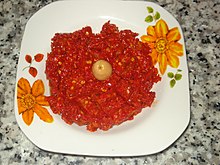Harissa
 | |
| Alternative names | هريسة |
|---|---|
| Type | Paste |
| Region or state | Maghreb |
| Main ingredients | Red peppers |
| Ingredients generally used | Baklouti pepper |
Harissa (
Etymology
The word derives from the Arabic root 'harasa' (
Consumption and culinary traditions
Algeria
In Algeria, harissa is commonly added to soups, stews, and couscous.[8] Harissa paste can also be used as a rub for meat[9] or eggplants.[10] Another significant producer is Algeria's Annaba Province,[11] which is also a significant consumer.[12] According to cookbook author Martha Rose Shulman, premade harissa tastes rather different from that which is served in Tunisian and expatriate restaurants.
Israel and Libya
In Israel, harissa is a common topping for sabich[13] and shawarma.
Filfel chuma (
Morocco
Tunisia
Recipes for harissa vary according to the household and region. Variations can include the addition of
Tunisia is the biggest exporter of prepared harissa.[22] In 2006, the Tunisian production of harissa was 22,000 tonnes, incorporating about 40,000 tonnes of peppers.[23] Tunisian harissa is often made with Baklouti peppers[24] and chilis grown around Nabeul and Gabès, which are relatively mild, scoring 4,000–5,000 on the Scoville scale.[25] On December 1 2022, UNESCO added "Harissa, knowledge, skills and culinary and social practices" as part of Tunisia's Intangible Cultural Heritage.[2][3]
See also
References
- ^ @NatGeoUK (2019-08-16). "Breaking bread: coastal cuisine and family feasts in Tunisia". National Geographic. Retrieved 2021-01-05.
- ^ a b unesco. "New inscriptions to the UNESCO Intangible cultural heritage". Retrieved 1 December 2022.
- ^ a b "UNESCO - Harissa, knowledge, skills and culinary and social practices". ich.unesco.org. Retrieved 2022-12-01.
- ISBN 978-0-8118-1503-1.
- ISBN 978-0-544-18750-4.
- ^ Jose (2016-07-22). "The Story of Harissa". Belazu Ingredient Company. Retrieved 2021-02-08.
- ^ "Le Mehres, un outil de grand-mère qui n'a jamais perdu son charme". tunisie.co. 2023-09-17. Retrieved 2023-09-17.
- ISBN 978-1-4496-5968-4.
- ^ Fayed, Saad. "Flank Steak with Harissa". About.com. Archived from the original on 2009-06-08. Retrieved 2009-08-02.]
- ^ "Baby Eggplant with Harissa and Mint". Ashbury's Aubergines. Retrieved 2009-08-02.
- )
- ISBN 978-0-313-37626-9.
- ISBN 978-1-78026-124-9.
- ^ ISBN 9780805212242
- ^ How to make Libyan maseer
- ^ North African hot recipes
- ^ How to prepare mseyer in the Libyan cuisine
- ^ Benkabbou, Nargisse (2016-07-12). "Harissa". My Moroccan Food. Retrieved 2024-03-11.
- ISBN 978-1-118-09875-2.
- ISBN 978-0-684-80275-6.
- ISBN 978-0-7614-7571-2.
- ^ Tunisian Harissa Export cepex.nat.tn Archived September 6, 2009, at the Wayback Machine
- )
- ISBN 978-1-60433-733-4.
- ISBN 978-1-74179-001-6.
